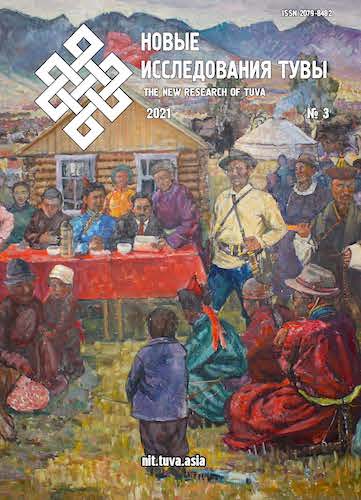Religious and cultural space of Chasovennye Old Believers in illustrations to their new-printed books
DOI:
https://doi.org/10.25178/nit.2021.3.10Keywords:
Old Belief; Chasovennye soglasie; Yenisei Siberia; new-printed books; illustration; visual anthropology; Tuva; Krasnoyarsk Krai; Khakassia; Irkutsk OblastAbstract
Literacy is a basic element of Old Belief culture. Alongside with early printed books being retained and reproduced, script books and manuscripts have always been an integral part of the movement. To a large extent, the tradition was maintained by the Chasovennye (“chapel goers”, a non-priestly faction among Old Believers), who strictly adhered to the rule of never publishing their literature in “external” printing houses. In Yenisei Siberia, where they owned no printing housess, skete scriptoria were used as workshops for manuscripts to be hand-copied, illustrated and bound, thus producing handmade books. However, the ongoing process of creating the literature they required and the growing social demand for it provided the impetus for the developing soglasie (accord) to reconsider a number of doctrinal attitudes and principles and to start producing their own books, first hand-written and then printed in semi-uncial script (poluustav), in printing houses located in cities. These new-printed books were the phenomenon of the contemporary culture of the Chasovennye Old Believers in Krasnoyarsk region, Tuva and other regions of the country and in the world.
Along with the textual content of the books, of great interest is the tradition of illustrating them, inseparably linking the tradition of in designing Old Believers’ printed books and manuscripts, to the innovative approach manifested in the apparent influence imposed by Russian and foreign (predominantly American) art with which contemporary skete indigenes are well acquainted. The evident traces of such influence are indicative of the general character of the group’s contemporary culture evolving.
Of particular interest are the ways of portraying characters, objects, and loci of religious and cultural space of this relatively closed group. If considered from a comprehensive perspective, they represent visual self-reflection of their church. Their interaction with the text, on the one hand, allows implementing the doctrine, and on the other hand, manifests the logic of contemporary development of skete art. Thus it becomes possible to trace the development of both the artist’s mindset and that of the addressee of the artist’s works, that is members of the of Chasovennye accord.
References
Bykova, E. V. and Prigarin, A. A. (2019) Vizual'nyi obraz chernoriztsa v starovercheskikh rukopisiakh na Enisee [Visual image of a monk in Old Believer manuscripts on the Yenisei]. In: Materialy Mezhdunarodnykh XVIII etnograficheskikh chtenii «Etnos i konfessiia» [Proceedings of the International XVIII Ethnographic Readings "Ethnos and Confessions"]. Ed. by V. M. Grusman and E. E. Gerasimenko. St. Petersburg, IPC SPbGUND. 260 p. Pp. 33–38. (In Russ.).
Gur'ianova, N. S. (2017) Rukopisnye sborniki i oformlenie ideologii staroobriadcheskogo dvizheniia [Handwritten collections and design of the ideology of the Old Believer movement]. Novosibirsk, NIC Apostrof. 230 p. (In Russ.).
Zhuravel', O. D. (2012) Literaturnoe tvorchestvo staroobriadtsev XVIII — nachala XXI v.: temy, problemy, poetika [Literary works of the Old Believers in the 18th — early 21st centuries: themes, problems, poetics]. Novosibirsk, SO RAN Publ. 438 p. (In Russ.).
Kostrov, A. V. (2019) Novopechatnye knigi staroobriadtsev chasovennogo soglasiia: igra traditsii i novatsii [New-printed Books of Old Believers of Chasovennye Accord: A Game of Tradition and Innovation]. In: Trudy IV Mezhdunarodnoi nauchnoi konferentsii «Iazyk, kniga i traditsionnaia kul'tura pozdnego russkogo srednevekov'ia v nauke, muzeinoi i bibliotechnoi rabote» [Proceedings of the IV International Scientific Conference “Language, Book and Traditional Culture of the Late Russian Middle Ages in Science, Museum and Library Work”]. Comp. by Yu. S. Belyznkin, E. V. Vorontsova and N. V. Litvina. Moscow, MGU Publ. 783 p. Pp. 165–175. (In Russ.).
Kostrov A. V. (2021) Fenomeny kultury sovremennyh staroobradcev-chasovennyh Eniseiskoi Sibiri [Cultural Phenomena of modern Old Believers belonging to Chasovennoe soglasie of Yenisei Siberia]. Krasnoyarsk, KASS. 412 p. (In Russ.).
Pokrovskii, N. N. and Zol'nikova, N. D. (2002) Starovery-chasovennye na vostoke Rossii v XVIII–XX vv.: Problemy tvorchestva i obshchestvennogo soznaniia [Chasovennye Old Believers in the East of Russia in the 18th–20th Centuries: Problems of Creativity and Social Consciousness]. Moscow, Pamiatniki istoricheskoi mysli. 471 p. (In Russ.).
Published
How to Cite
Для цитирования:
Kostrov A. V. and Elohina Yu. V. Religious and cultural space of Chasovennye Old Believers in illustrations to their new‑printed books // Новые исследования Тувы. 2021, № 3. С. 128-136. DOI: https://www.doi.org/10.25178/nit.2021.3.10
Issue
Section

This work is licensed under a Creative Commons Attribution-NonCommercial 4.0 International License.

Author(s) license holder(s) grant rights for their work to the journal (grantee of a license) under the simple non-exclusive open license in accordance with Art. 1286.1 «Open license for a research work, work of literature or fine arts», Civil Code of the Russian Federation.
New Research of Tuva publishes articles under the Creative Commons Attribution-NonCommercial license (CC BY-NC).
Since it is an open license, author(s) reserve the right to upload the article to their institutional repository, submit it to another journal (if it allows republications), or republish it on their own website (in full, or in part).
However, several conditions apply here:
a) The republished version must always contain the name(s) and affiliation(s) of the author(s), the original title and the hyperlink to the original version on the New Research of Tuva website;
b) It must be in open access, free of charge, and no category of readers must be in any way whatsoever advantaged over general readership.
c) should the contribution be submitted elsewhere by its author(s) without substantial modification (30% or more of original text unchanged), the body of the article should contain a disclaimer that the original version was published in New Research of Tuva (with a link to the respective page)
The CC-BY-NC is a non-revocable license which applies worldwide and lasts for the duration of the work’s copyright.










